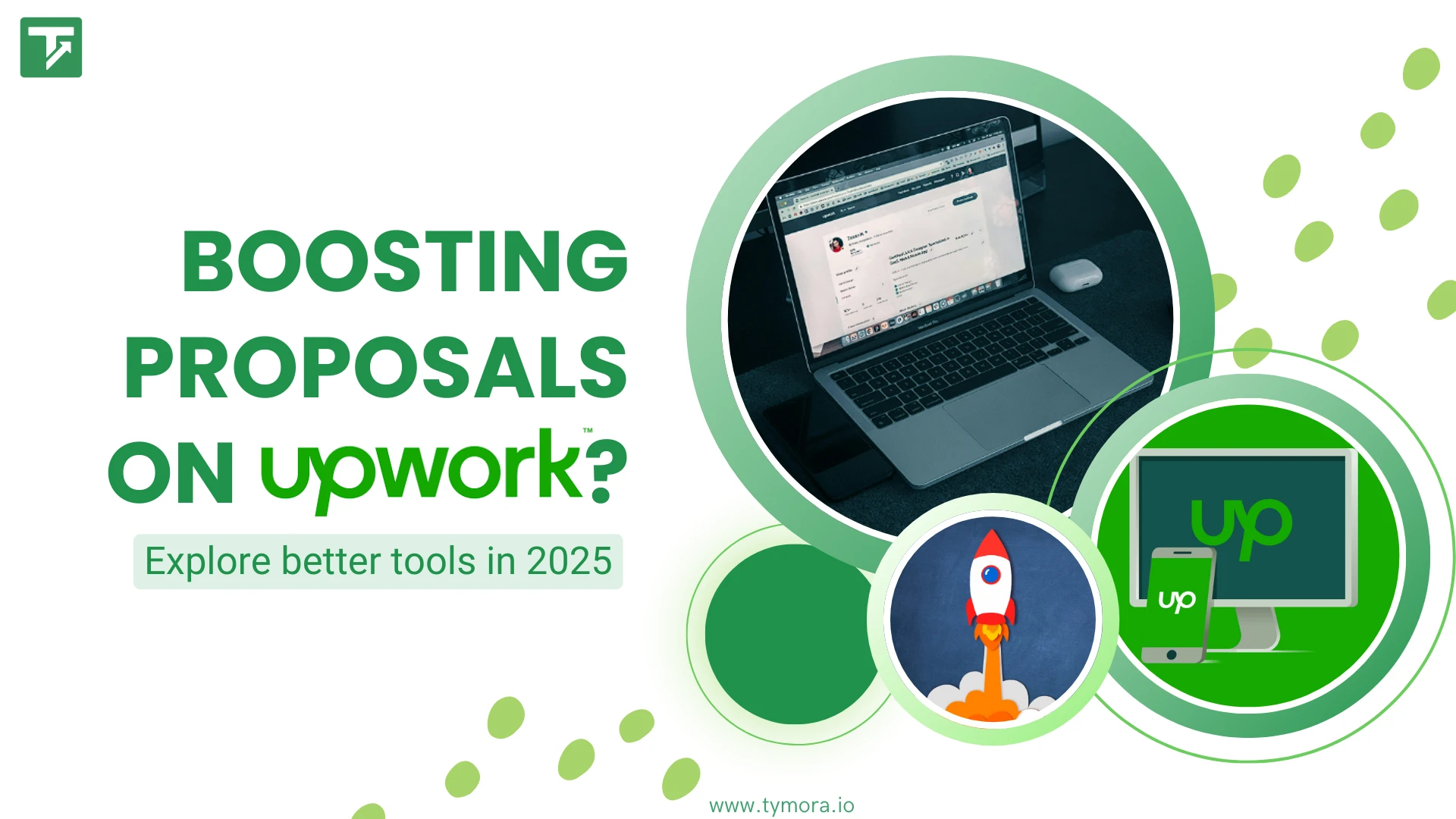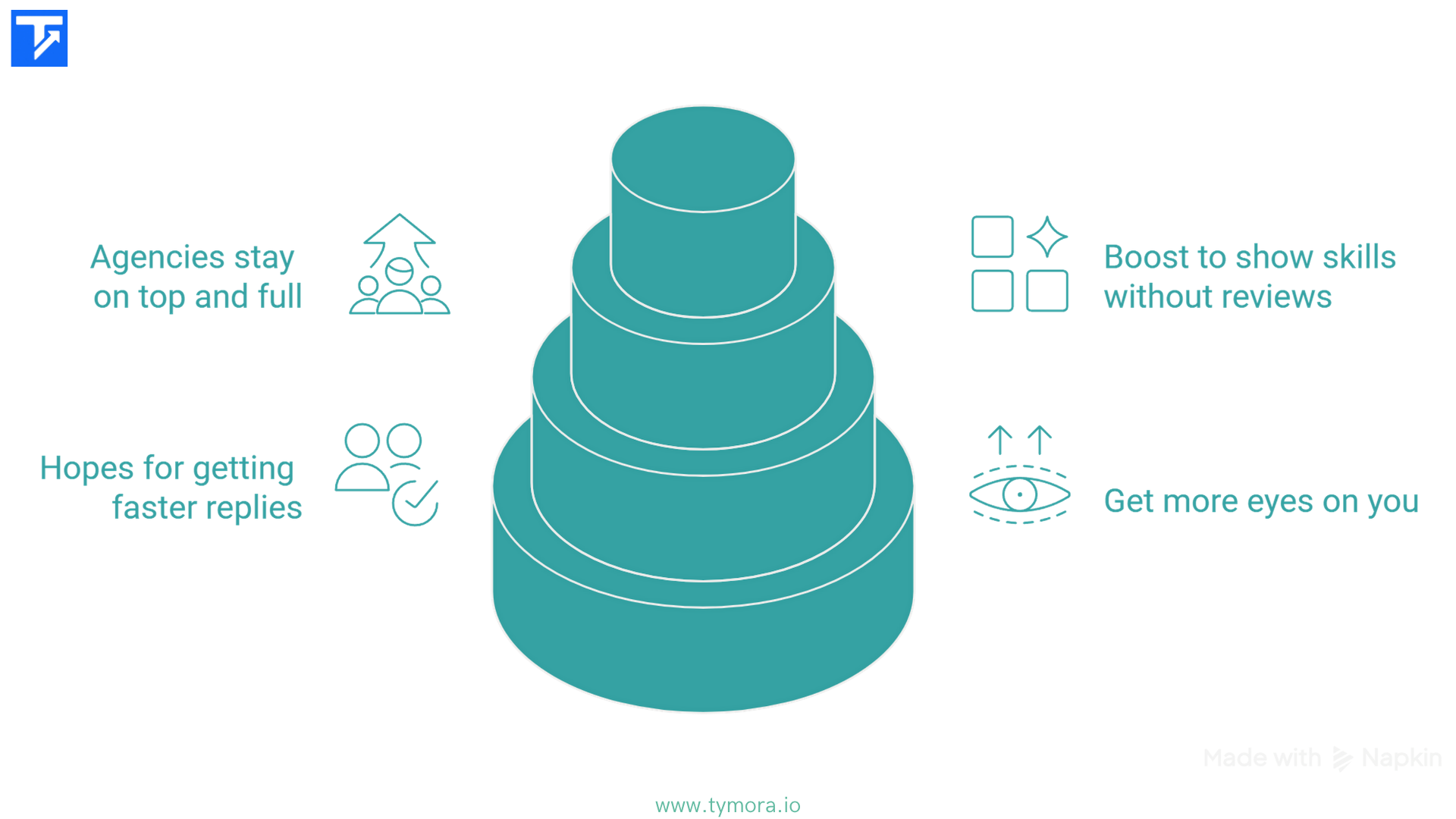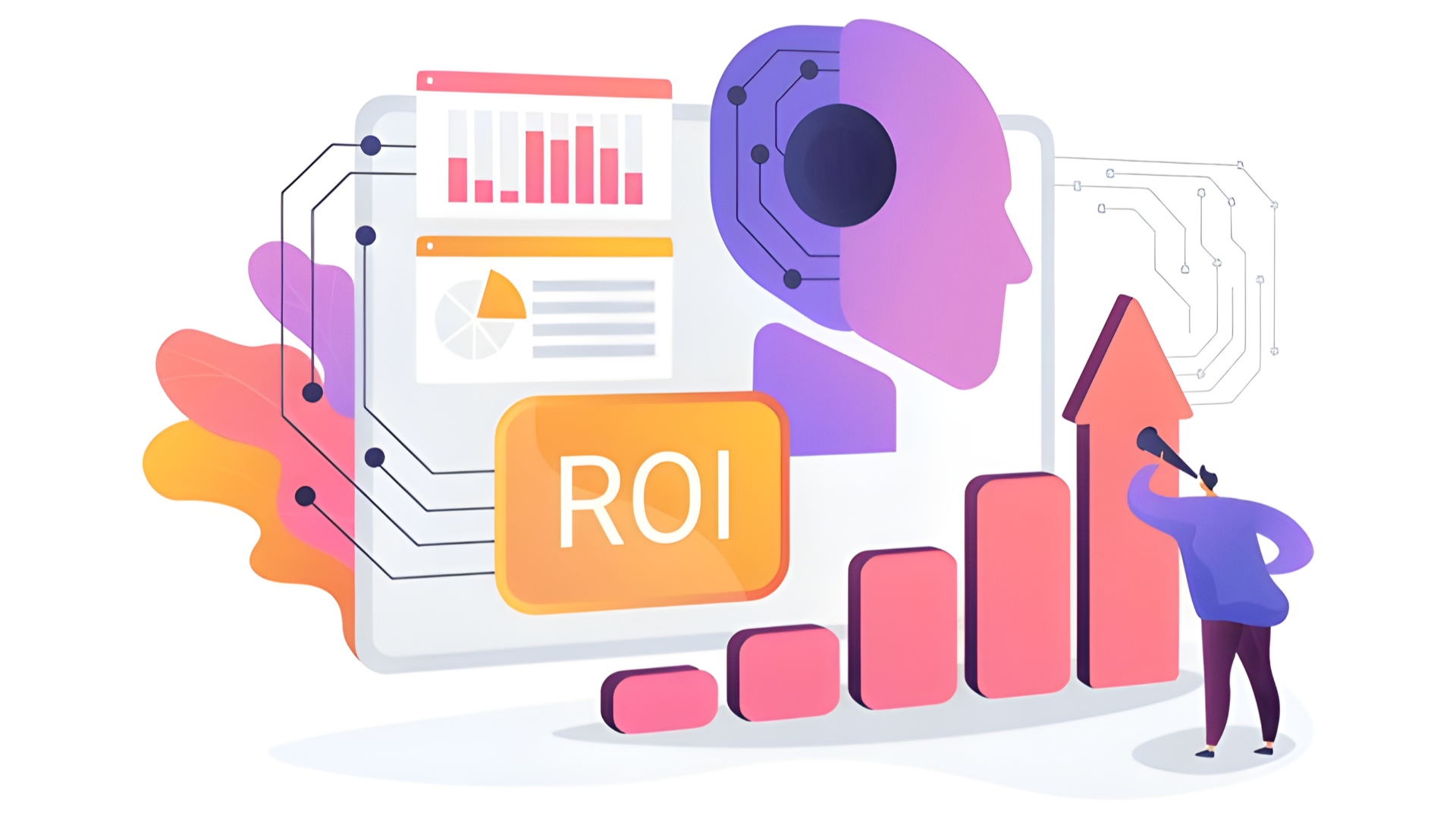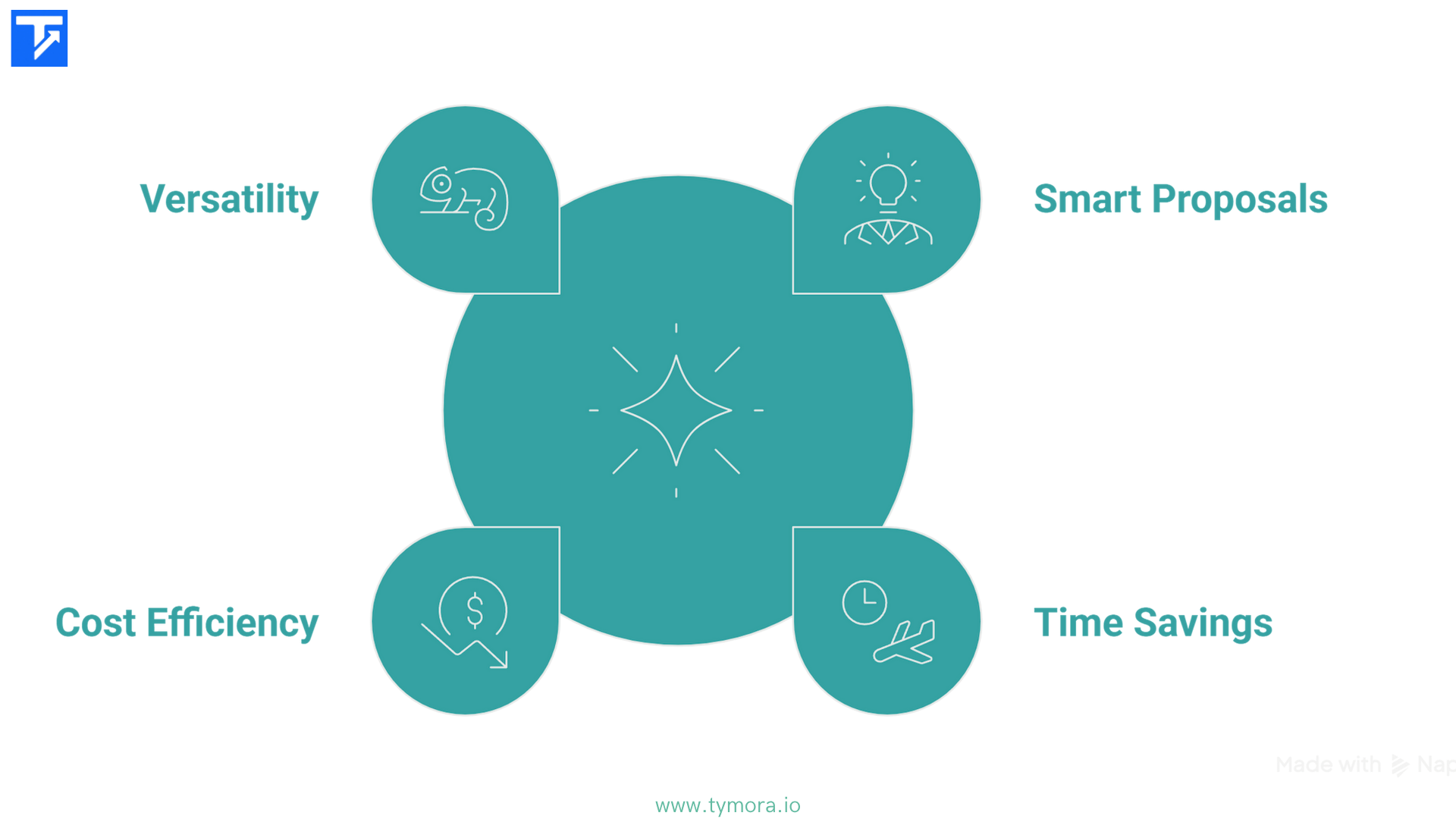Upwork Boosted Proposal: Worth the Hype in 2025?

If you’re a freelancer or agency on Upwork, chances are you’ve already heard of the Upwork Boosted Proposal feature. Maybe you’ve even spent some connects to get your proposal front and center.
But here’s the burning question every freelancer asks:
“Is boosting my proposal enough to land the job?”
Short answer? No.
In 2025, the competition is tougher, the clients are smarter, and the boosted proposal game is no longer just about being seen it’s about being compelling. Upwork Boosted Proposals might help you rise to the top, but without high-quality, personalized content underneath, you’re still invisible to the client.
Table of Contents
What Exactly Are Upwork Boosted Proposals?
Think of boosted proposals as “sponsored ads” for freelancers. Just like brands pay Google to show their ad first, freelancers can pay Upwork extra Connects to push their proposal to the very top of a client’s inbox.
Here’s how it works in simple terms:
- Every job on Upwork requires you to spend Connects (Upwork’s virtual currency) just to apply.
- Normally, proposals appear in the order they’re submitted, or based on Upwork’s internal algorithm.
- But with boosting, freelancers can bid extra Connects to “sponsor” their proposal.
- The highest bidders land in the top three “boosted slots” that clients see first.
Thus, you’re paying to avoid the line rather than simply waiting in it.
A Quick Example
A Quick Example
Imagine this:
- Freelancer A applies for a job with a minimum of 8 Connects.
- Freelancer B applies for the same job but chooses to “boost” with an extra 15 Connects (total 23).
When the client opens their inbox, guess whose proposal they see at the very top? Freelancer B.
Even if Freelancer A has a stronger portfolio, they risk being buried under dozens of proposals. Freelancer B’s proposal gets that initial visibility boost, like having a VIP pass in a crowded concert.
That’s the promise of boosted proposals: pay more, get seen more.
Quick Stat:
According to Upwork’s own blog, boosted proposals are 3.6x more likely to be seen by clients compared to non-boosted ones.
But seen doesn’t always mean read and certainly doesn’t mean hired.
Why People Fall for the Boost Proposal?
Let’s be honest boosted proposals sound almost too good to resist.
Freelancing is tough. You spend hours polishing your proposal, tailoring it to the job, and hitting submit… only to wait. Days go by, weeks even, and sometimes you don’t even get a “view.” Your proposal just sits there, buried under 40, 80, sometimes 200 other freelancers all chasing the same gig.
Then Upwork whispers: “Hey, if you spend just a few more Connects, we’ll make sure your proposal is one of the first things the client sees.”
That’s the hook.
And honestly, who wouldn’t be tempted?
Why It Feels Attractive?

- You want to stand out in a sea of proposals: Imagine being client number 75 in a stack of 120 proposals. The odds of even getting opened are slim. Boosting feels like a ticket to visibility finally, your hard work will actually be seen.
- You’re tired of waiting weeks for replies: Nothing stings more than silence. Boosting seems like the fast-forward button, you skip the queue and get your proposal right where it matters most: the client’s screen.
- You’re new and just want your first job: If you’re just starting out, everything feels stacked against you no reviews, no job history, no social proof. Boosting feels like the one lever you can pull to level the playing field.
And let’s be real:
If paying a little more could put you at the top, why wouldn’t you try it?
The Psychological Trap
Here’s where it gets interesting. Boosting isn’t just about logic, it plays with psychology.
- It feeds on fear of missing out (FOMO). “What if I don’t boost and lose this client forever?”
- It promises a shortcut in a system that feels unfair. Everyone wants a hack to skip the grind.
- It gives a sense of control. Freelancers often feel powerless, waiting on clients. Boosting feels like taking action.
That’s why so many fall for it. It’s not that boosting is bad, it’s that it creates the illusion of guaranteed success.
But here’s the truth we’ll explore next: visibility doesn’t always equal victory.
The Bright Side: When Boosting Can Actually Help
Okay, so far we’ve been a little cautious about boosted proposals but here’s the good news: they’re not all bad. Indeed, boosting proposal can provide the precise push you require in the appropriate circumstance.
Think of it like paying for a front-row seat at a concert. You’re still watching the same show as everyone else, but your view is better. On Upwork, boosting doesn’t magically make you the best freelancer, it just ensures the client actually sees you. And sometimes, that visibility makes all the difference.
Why Boosting Proposal Can Be Useful?

- Visibility: Let’s face it, even the strongest proposals can get lost if they’re number 89 in a pile of 120. By boosting, you’re buying yourself a guaranteed “first impression” spot. That means the client is more likely to at least skim your pitch, and that’s half the battle won.
- Faster client replies: Many clients hire within the first few hours of posting a job. If your proposal shows up at the top right away, you’re in their line of sight during that critical decision window.
- Helpful for beginners who need that initial push: When you’re brand new, you don’t have the reviews or job history that Upwork’s algorithm loves. Boosting gives you a chance to say: “Hey, I may not have reviews yet, but look at my skills.” It’s like putting a spotlight on yourself in a crowded room.
- Agencies can scale quickly with consistent top placement: For agencies handling multiple projects, visibility at scale matters. Consistently appearing at the top helps them keep pipelines full, even if it costs more Connects. For them, it’s often worth the tradeoff.
Example
Imagine you’re a new graphic designer.
You’ve polished your Upwork profile, uploaded some shiny portfolio samples, and written a killer proposal for a logo design gig. Normally, you’d be one of 50 proposals sitting in the client’s inbox, probably never opened.
But this time, you decide to boost. You spend 20 Connects instead of 8.
Now, when the client logs in, your proposal is the first thing they see.
They might still scroll through a few others, but they’ve already read your pitch, already looked at your designs, and already formed a mental note: “This one looks good.”
That early impression can completely change your chances.
Fun Fact: According to Upwork’s 2024 transparency report, clients are 3x more likely to view boosted proposals than regular ones. In the same report, nearly 60% of jobs had at least one boosted proposal in the top three slots.
The Catch: Why Boosted Proposals Can Backfire
So yes, boosted proposals can put you in the spotlight. But here’s the kicker: visibility doesn’t guarantee victory. Just because your proposal is at the top doesn’t mean the client will hire you. And that’s where boosting can start to feel like pouring money into a bottomless pit.
Let’s break down the main problems freelancers face when relying too much on boosting.
1. It Gets Expensive, Fast
Boosting isn’t free, it eats up your Connects like wildfire.
- A normal proposal might cost 8 Connects.
- Boosting could add another 10–20 Connects depending on the competition.
That means a single proposal can cost you 30 Connects.
Now do the math:
If you send out 20 boosted proposals in a month at 25 Connects each, that’s 500 Connects.
At Upwork’s price of roughly $0.15 per Connect, you’re looking at $75 a month, just on proposals.
That’s not pocket change for freelancers still struggling to land steady work.
2. It’s a Bidding War
Boosting feels like a race with no finish line.
- You bid 15 extra Connects.
- Someone else bids 20.
- An agency swoops in with 35.
Even after using your hard-earned Connects, you are suddenly removed off the list once more. It’s similar to an auction where there is no assurance that you will win and the regulations are constantly changing.
3. Being Seen ≠ Being Hired
Here’s the hard truth: clients don’t hire the proposal at the top. They hire the one that feels right.
If your proposal is poorly written, generic, or irrelevant, it doesn’t matter if it’s boosted. Clients may read it, but they’ll still pass.
Think boosting to be similar to placing a billboard on the busiest road. Even if people will notice it, it will be insignificant if the message isn’t compelling.
4. It Can Feel Unfair
Many freelancers argue that boosting favors the “big fish.”
- Solo freelancers with limited Connects burn through their stash quickly.
- Agencies with deeper pockets can outbid everyone consistently.
- Mid-level freelancers often get squeezed in the middle.
This implies that the playing field isn’t always even, which quickly leads to irritation.
Example: Burning Connects with No Results
Meet Ravi, a mid-level web developer.
In one month, he decided to go all-in on boosting. He spent over 100 Connects across five jobs, often bidding 20–25 Connects per proposal. That’s about $15 worth of Connects just to get visibility.
Guess what? He didn’t land a single contract.
Why? Because while his proposals were boosted, they weren’t personalized enough. Clients saw them, skimmed them, and moved on. Ravi’s problem wasn’t visibility it was value.
The result? Burned money, burned confidence, zero jobs.
The Bottom Line
Boosting can open the door but it doesn’t guarantee anyone will walk through it.
- It’s costly.
- It’s competitive.
- It doesn’t solve the bigger issue of writing a proposal that actually converts.
That’s why many freelancers end up frustrated, wondering: “Am I just paying Upwork to stay broke?”
Freelancers vs Agencies: Who Gets More Out of Boosting?
Here’s the honest truth: boosting doesn’t play out the same for everyone. A brand-new freelancer, a mid-level one, and an agency can all boost their proposals but the outcomes are wildly different.
Take Maya, a new freelancer. She’s hungry for her first job, no reviews, no track record. For her, boosting feels like oxygen finally, she can put her proposal right in front of the client instead of being buried. And sometimes, it works. She might land that all-important first review faster. But here’s the catch: her Connects vanish almost overnight, and unless she writes standout proposals, boosting becomes an expensive crutch.
Now meet Daniel, a mid-level freelancer. He’s done a few projects, has some nice 5-star reviews, and wants to climb higher. For him, boosting is hit or miss. On small gigs, it’s not worth it. On high-value jobs, it sometimes makes sense. But Daniel often finds himself squeezed, too small to outbid agencies, too experienced to rely on boosting alone.
Finally, picture StudioX, a small agency. They’ve got a team, a budget, and multiple clients to feed. Boosting for them is like buying ads they can afford it, and it helps them stay consistently visible. But even then, boosting eats into margins, and doing it at scale gets pricey.
So, who really wins? Agencies tend to get more out of boosting simply because they can spend more. But for freelancers, boosting is more like training wheels, it might help you balance in the beginning, but you can’t ride with them forever.
The Real Problem No One Talks About
Here’s the thing no one tells you about boosted proposals: they only solve half the problem.
Yes, boosting proposal helps you get seen. That’s important. But getting seen doesn’t mean you’ll get hired.
Think about it: clients don’t open Upwork and say, “I’ll just hire whoever paid the most Connects.” They hire the freelancer who shows the most value, the one who understands their needs, offers a clear solution, and feels trustworthy.
Boosting proposal can put you in the client’s inbox, but it can’t make your proposal better.
1. The Visibility Trap
Boosting feels like the easy fix because it tackles the most obvious pain point:
“I just want clients to notice me!”
But once you’re noticed, the spotlight’s on you. If your proposal is generic, rushed, or doesn’t speak to the client’s problem, boosting won’t save you.
It’s like buying a fancy neon sign for a restaurant that still serves bland food. Sure, people will walk in, but will they stay? Probably not.
2. The Value Equation
The real formula for winning jobs isn’t just:
Visibility = Success
It’s actually:
Visibility + Value = Success
- Visibility gets you in the door.
- Value (your proposal, your portfolio, your skills) keeps you there and gets you hired.
Boosting proposal can only help with visibility. If you don’t deliver value, the boost is wasted.
Why ROI Matters More Than Visibility?

Many freelancers forget about ROI (return on investment).
Let’s say you spend $50 on boosting in a month. If that $50 gets you one $1,000 contract, amazing; you win.
But if that $50 disappears and you land nothing? That’s not a strategy, that’s gambling.
That’s the real problem: boosting proposal feels like a strategy, but without value behind it, it’s just throwing Connects into the void.
A Quick Story
Take Aria, a content writer. She boosted five proposals in a week, landing her at the top of every client’s inbox. Great, right?
Except her proposals were copy-paste templates. She didn’t personalize, didn’t address the client’s pain points, didn’t show how her writing would solve their problems.
The result? Zero hires.
The clients saw her but they weren’t convinced.
Aria didn’t have a visibility problem. She had a value problem.
And that’s where most freelancers go wrong. They think boosting will fix everything. But the truth is: visibility without value is just wasted money.
A Smarter Way Forward: How Tymora Fits In
So far, we’ve seen both sides of boosting: the thrill of being noticed and the sting of wasting Connects without results. The truth is, boosting only solves step one of freelancing success visibility. What freelancers really need is a way to consistently deliver value without burning out.
That’s where Tymora comes in.
Imagine This
You’re Alex, a mid-level freelancer. You’ve tried boosting, and yes it helped you get a few views. But most of the time, clients skimmed your proposal and never replied. You realized the problem wasn’t getting seen. The problem was that your proposals weren’t strong enough, or worse, they all sounded the same.
Now imagine instead of boosting, you open Tymora. With one click, it auto-generates a personalized, client-specific proposal using your portfolio data. No copy-pasting. No guesswork. Just a clear, tailored pitch that speaks directly to the client’s needs.
Suddenly, you’re not just visible you’re valuable.
Why Tymora Works Smarter?

Unlike boosting, Tymora doesn’t just throw your proposal to the top of the pile and hope for the best. It helps you stand out based on substance.
- Auto-generates personalized proposals from your portfolio: Every proposal is tailored, not generic clients feel like you wrote it just for them.
- Saves time and cuts proposal fatigue: No more spending hours writing 10 proposals a day, or copy-pasting the same lines. Tymora does the heavy lifting.
- Affordable compared to buying endless Connects: Instead of paying Upwork $50–$100 a month for visibility, Tymora helps you win more with fewer proposals.
- Works for both solo freelancers and agencies: Whether you’re one person hustling for your first client or an agency managing multiple accounts, Tymora scales with you.
Boosted Proposals vs Tymora
| Feature | Boosted Proposals | Tymora |
|---|---|---|
| Visibility | Guaranteed top spots (if you outbid others) | Organic visibility through strong, tailored proposals |
| Value Delivery | Doesn’t improve proposal quality | Personalized, high-value proposals that win trust |
| Cost | Expensive (20 boosted proposals = ~$75/month) | Affordable flat pricing |
| Sustainability | Short-term advantage, long-term drain | Long-term, scalable solution |
| Best For | Beginners needing a quick boost, agencies with big budgets | Freelancers & agencies looking for consistent, cost-effective wins |
Boosting can help you get noticed. Tymora helps you get hired.
And in the end, that’s what really matters. Clients don’t just want to see your proposal they want to be convinced by it. Tymora makes that part effortless, turning your visibility into actual contracts.
Also read our blog on:
- The 60-Second Upwork Proposal Framework That Converts 40% Better
- Upwork AI Proposal Generator – Tymora.ai
Final Thoughts: Should You Boost or Not?
So, are Upwork Boosted Proposals worth the hype in 2025?
The truth is, boosted proposals can help but they’re not a magic bullet. For beginners, they can be a useful way to grab attention and land that all-important first job. For agencies with bigger budgets, they can scale visibility. But for most freelancers, boosting comes with real limits: it’s costly, competitive, and only solves one part of the puzzle getting seen.
The real secret to winning on Upwork is combining visibility with value. Being at the top of the list means nothing if your proposal doesn’t resonate. That’s why tools like Tymora matter: they help you create personalized, high-quality proposals that actually convert, without burning through endless Connects.
So here’s the bottom line:
- Boost if you must, especially for high-value projects or when you need that extra push.
- But don’t rely on boosting alone; focus on crafting strong proposals that show clients you get them.
- Long-term success isn’t about paying more to be seen, it’s about being the freelancer who stands out for the right reasons.
Because in the end, clients don’t just hire the first proposal they see. They hire the one that feels like the best fit. And that’s where your value not your Connects; wins the day.
FAQs
1. Does boosting proposals on Upwork guarantee more jobs?
No, boosting only increases visibility, not conversions. Your proposal still needs to be personalized, relevant, and value-driven to win the job.
2. When should I boost a proposal on Upwork?
Boost proposal when the job is a strong match for your skills, has a solid client history, and offers good value. Avoid boosting generic or unclear job posts.
3. What makes a proposal stand out on Upwork?
Personalization, clear understanding of the client’s problem, relevant past results, and using the same language or keywords from the job post all make a proposal stand out.
4. How many Connects should I spend on a boosted proposal?
Start small and test. Often, moderate boosts (15–25 Connects) are enough to place you in the top 3. Track which levels bring responses in your niche.
5. Can AI tools help write Upwork proposals?
Yes. AI tools like Tymora analyze job posts and generate customized, keyword-rich proposals that save time and improve your chance of success.
Customer Success Stories
Tymora has completely transformed how I manage my freelance business. From invoicing to tracking expenses, everything is streamlined and effortless.
Monowar Iqbal Layek
Freelancer
Managing my freelance work is so much easier with Tymora. Invoicing is fast, expense tracking is simple, and I feel more organized than ever.
Sandeep Acharya
Freelancer
Tymora made managing my freelance projects and finances seamless. The platform is intuitive, and support is always responsive and helpful.
Samsur Rahaman
Automation Framework Architect